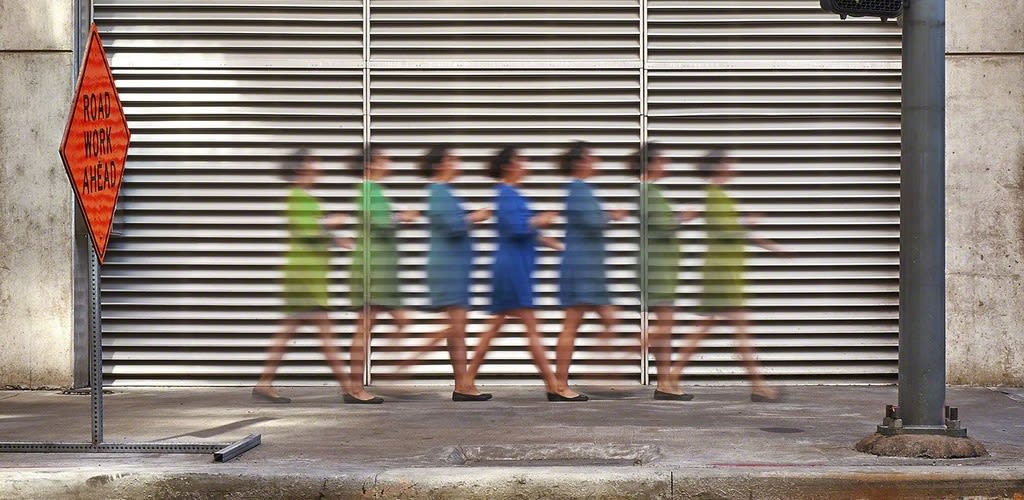
Photographers have always been interested in freezing a moment in time. Beaumont Newhall , in describing photography stated: “All good photography… holds a moment of time and a fraction of space forever; it reveals more than the eye can see; it discovers the world for us.” (1) It’s a wonderful statement of what all photographers with a vision to express want to achieve. An emerging conceptual photographer, Martin Holmes, has been experimenting with training his eye and imagination to do just this. Because of his own sense of isolation and the frenzy on city streets, Holmes, in his series “Time-Slip”, used photography as a tool to capture the tone, pace, motion and, for him, emotion of the streets. This commentary will explore his work over the last couple of years and highlight how this expression has evolved through 12 images that each represent different permutations of this still developing vision.
Holmes defied the conventional wisdom that all things have been photographed, as all photographers should. His interest germinated from a study of the streets of downtown Houston, Texas, exploring the creation of “streetscape” and “urbanscape” type images. While street photography is a classic and well known genre, he felt a need to express his own vision of what he saw and felt. One of his first images from the “Time Slip” series was “Don’t Walk”. Certain elements have been part of street photography for years: people rushing from place to place, responding to street signs and signals and avoiding cars, buses and trains. What Holmes captured was the frenzied pace of people within a composition framed by the downtown urban environment. We move instinctively between other people on the sidewalks and obstacles mechanically and by rote driven by a fear of time, delayed, interrupted and being late for our next appointment. These images visualize this pace for all types of people in motion on our streets.
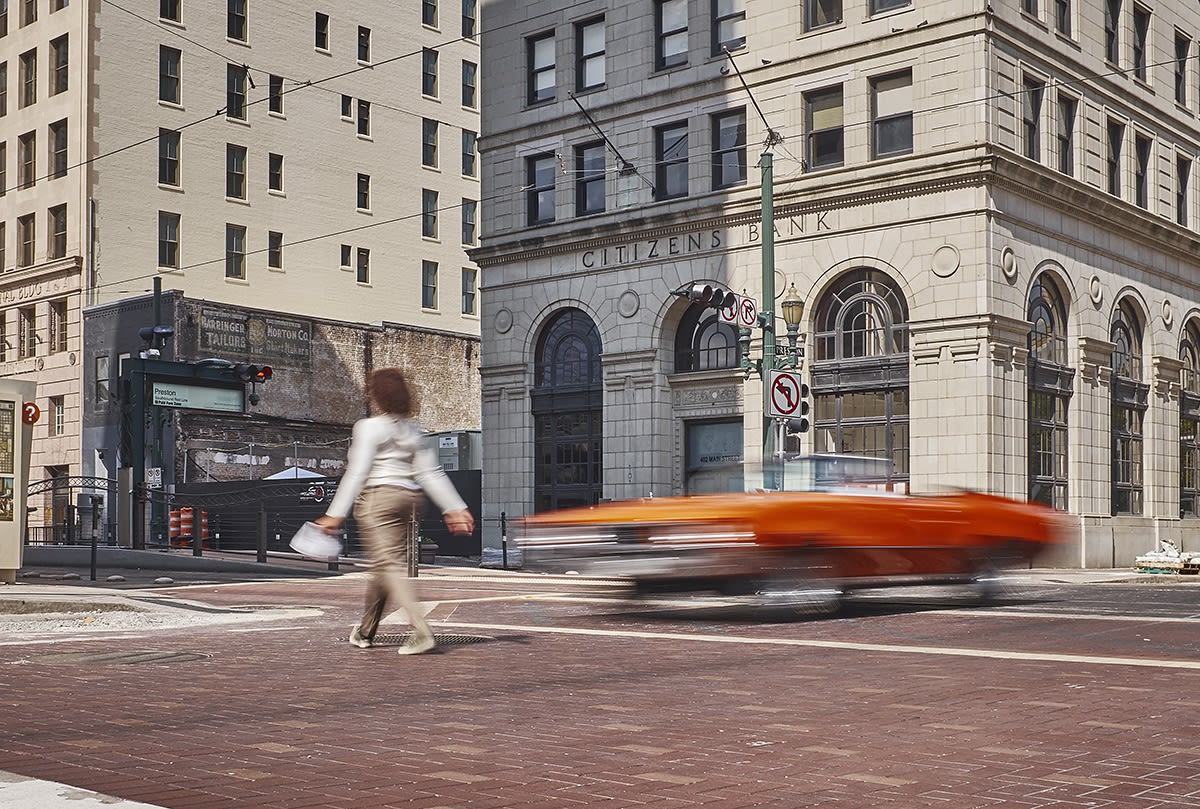
What is interesting about this series of images is watching the development of an artist at work building on a concept. These images layout for our study a process of trial and error that any artist goes through, but rarely can we witness the process. The series all starts with Holmes finding a street corner in downtown Houston, Texas from which to photograph street activity. Initially the images are caught moments, in the spirit of Henri Cartier-Bresson’s “decisive moments”. (2) In the 1986 edition of “A History of Photography”, edited by Jean-Claude Lemagny and André Rouillé, they quote Cartier-Bresson in stating that: “It is Cartier-Bresson who had produced the most perfect definition of the reporter’s action in taking photographs” … “Photography is the simultaneous recognition, in a single instant, of on the one hand the significance of a fact and, on the other, the rigorous organization of the visually perceived forms which express and give meaning to that fact”. While Holmes is not a reporter, and his images are not documentary, he is catching moments, and emphasizing them both with repetition and modification to communicate and give “meaning” to what he is thinking.
His next step in this visual journey was to capture an individual, not just showing motion, but the expression of motion and movement, between moving objects. It is reminiscent of the scientific stroboscopic photograph “Bob Running” of the movement images by Harold “Doc” Edgerton or “The Pendulum” from the motion studies of Berenice Abbott. (3)

Holmes does not think about his work as photography, but as art, where the camera is the tool used. In Beaumont Newhall’s “The History of Photography: from 1839 to the present day” (4), a chapter was devoted to “The Conquest of Action”. Cameras in the early days of photography were barely able to capture a clear image of an individual sitting much less in motion, given the limitation of lens, shutters and film sensitivity to light. Motion in still photography brings to mind immediately Eadweard Muybridge and his studies of movement. Perhaps the most famous is the 1878 image of a horse in motion which demonstrated that a horse actually ran with all four feet off the ground at one part of a gallop, which was very different than what was thought. Muybridge expanded what we were able to now see. Like Muybridge, Holmes is able to take advantage of the digital technology today to capture images that allows us to see our own movement on city streets differently.
Holmes then experimented with capturing a lone individual in a more extended range of motion. In the image “Glum”, Holmes has moved the background from a street setting of buildings to one framing the activity with the side of a building. He chooses his sites carefully. The selection process involves a background that will match in some manner the color and attitude of the person shown. The hustle and bustle of the street is felt. The image is a combination of the stationary building wall, a walking person in clearly separate motions of walk, against yet a third type of motion that is captured, the quickly moving car that is a lone blur going the opposite direction.

He continued the “Time Slip” series experiment with a group of images subtitled “Street Portraits”. The image now becomes a study of one person. Our actions on the streets of the city is a study in movement that is choreographed within the stage of the urban environment we walk through most everyday. The series “Street Portraits” is a study of movements on the street focused on our own gestures, the actions of those around us, signs or barriers that impede our progress. While we sometimes “walk in a daze”, we may also interrupt our own rapid pace by a phone call, a “pearl of wisdom” we want to capture and write down or a call we suddenly remember to make. The camera captures the visual pace and actions, parts of which are emphasized in post processing to examine our conscious and unconscious behaviors. The images reflect what we do and how we are controlled as we ping-pong from place to place in our ever more crowded downtown urban environment.
His selection of who is photographed now speaks to what we are all guilty of at one time or another – walking while our mind is distracted with other thoughts of something else, another time and place or people, deep in thought. “Distraction”, appears to capture a woman walking and reading something off her cell phone. A very typical, everyday feature seen all the time on the street, and many other places. The artist does wonder if this image will be “dated” by the cell phone because one day a new technology will replace it. Future images may indeed show us walking wearing a visual reality headgear totally oblivious and detached from our surroundings. Rather than engaged with others or our surroundings, we are transported by our mobile devices to some other place. The term “Time-Slip” now has another meaning. Its not only our own passage through traditional time and space. In “Distraction” , the Time-Slip is suggesting missed time. How often have we been so lost in thought, that when we emerge from our thoughts and break through, as we come up for air so to speak, figuratively and perhaps literally, we wonder where we’ve walked, and where are we?

In the last example of Holmes’ work in this sampling of the “Time-Slip Street Portraits” series, he experiments with colorizing the images to apparently give the image a more fanciful, less documentary look. “Rainbow Dress” is his first effort trying to use the camera and Photoshop as tools of fabricated artistic expression, rather than as a literal photographic image. Up until this point, Holmes had used the tools in Photoshop as a substitute for a traditional “wet” darkroom to create a print from an image (or images) he has taken, rather than to manipulate and create an “artificial” image. Muybridge had captured motion using multiple cameras creating many separate images that were presented separately as distinct prints aligned together to illustrate motion. What Holmes did in photoshop was to take multiple images and stack or combine them in photoshop. This is no different than the layering of traditional film images by artists like Jerry Uelsmann. However, he then departs from a traditional photographic approach with the “Rainbow Dress” image using Photoshop as a tool to create this unrealistic image.

Holmes also becomes interested in the challenge of extracting and directing the focus of a viewer’s attention to one person out of the many in a crowd of people. From a professional standpoint, he has also joined an outside group of artists, other than photographers, to look at and critique works of others in the group. He is listening to the statements by non-photographic artists talking about what they are doing and why. Whether consciously or not, he also appears to have been exposed to the photo collage/ photomontage work of the dadaist and surrealists. He seems driven by a desire to convey his own state of mind in these images, creating his own photographic expression, albeit an artificial image. In this image another new element is added to the visual composition: signs. Part of Holmes’ sense of the street is not only the pace of distracted people walking alone within a bustling environment, but how that movement is regulated. Our movements in these urban environments are controlled. We have lines to walk between. We have signs to tell us to “Stop” and to “Go”. To walk. To not walk. Warning signs. Signs of instruction, as well as direction. Holmes identifies with these signs. While the sign in this image is literal, in later images the signs and objects on the street begin to take on a very different character.
Holmes’ next extension of expression about our urban landscape is the series “Throwing Bones”. Still a part of the “Time-Slip” series as a whole, he described this direction in his work as follows (5): “Society is a concept with many definitions. It might be considered a community with a common set of laws and beliefs. While some societies are homogeneous, there are societies whose fabric holds in its embrace differing views and behaviors, but not always easily acknowledged. The act, or expression, of “throwing bones” is a term that implies connectivity. It may be a term rooted in throwing bones to dogs to bring them closer into human connectivity; in some cultures it was a practice to tell the future. Today, it may be an expression for drawing attention to one’s self or the act of reaching out to another for inclusion.” Martin Holmes’ series “Throwing Bones” is about inclusion, belonging and acceptance; not predicting the future. Visual images are Holmes’ “bones”. He looks for a “special place at a special time” to collect as much visual information as he can, take it home, and interpret it. The visualization of motion, in part, is an individual’s self-perception about him/herself: connection with others, fears and navigating social norms and laws. It’s about being an engaged person (but, sometimes feeling like an island) building and maintaining relationships. There is anxiety in the blurred motion. Holmes uses different techniques to illustrate the fear that one’s reality and accomplishments are not real; the risk of discovery as a fraud. Society is not static; it keeps changing. We resist change and become as immoveable as a fire hydrant: hardened and set in place, and yet providing an invaluable service. For Holmes, “Throwing Bones” is a part of a “fabricated” body of work dealing with urban life.
Lemagny and Rouillé made the following observation about “fabricated photography”. “Fabricated photography or ‘staged photography’ is directly descended from the conceptual movement and from surrealist inspiration. … Fabricated photography of this kind becomes possible when the most important thing for the author is no longer to invent beautiful objects but to demonstrate his own concept of art… his purpose is to construct something completely artificial”. (6) This text as written in 1986. Now, 30 years later, their discussion seems to reach out to Martin Holmes’ art effort using digital rather than traditional photography as the tool. Neither is the “straight photography” advocated by Ansel Adams and Edward Weston and the F.64 photography group. (7)
In the image “Adrift”, Holmes now adds to the background a mirrored image in motion, rather than just a wall or street scene. There is still a sign whichis an artist’ message to the viewer to consider. But there is a more fundamental change. He takes one of the figures in the image and makes a physical change, taking an inanimate object and giving it an emotional meaning as a replacement for the head on one of the participants in the scene. In this case a fire hydrant. His art is anthropomorphic – the attribution of a “human shape or characteristic to [an] inanimate thing”. (8)
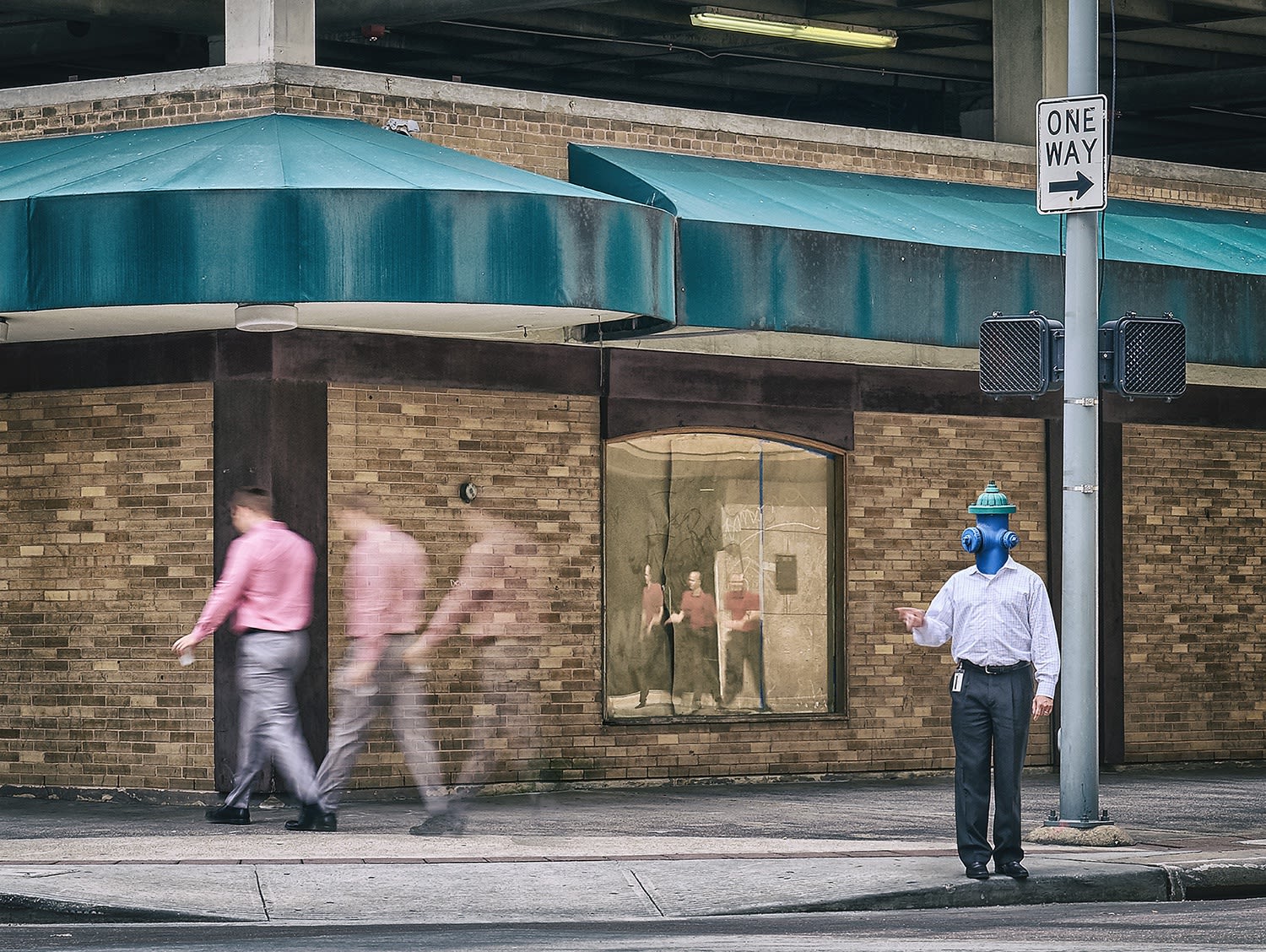
He then takes an additional step in “Recognizing Interference”. He returns to a neutral background to emphasize the people. The use of inanimate objects embedded into figures is continued as he had done in the image “Adrift”. But two new communications were added. Where before he had incorporated an unmodified street sign, a street sign is now added that has been manipulated to give an other than literal message. The other figures of people in motion are faded and made blurry. These other faded figures in motion are pushed into the background more as props to just remind us that the action is in an urban setting.

With the image “Discord”, the figures now become part of the emotional expression of the artist. Instead of a faded image that appears as a backdrop, the images themselves are modified with noticeable red curved nodal type lines to convey an additional message. The use of the street signs has also changed. Rather than a detached “message” where one would normally expect to see a sign, the sign has now become part of one of the people on the street, making it an even more personal expression.
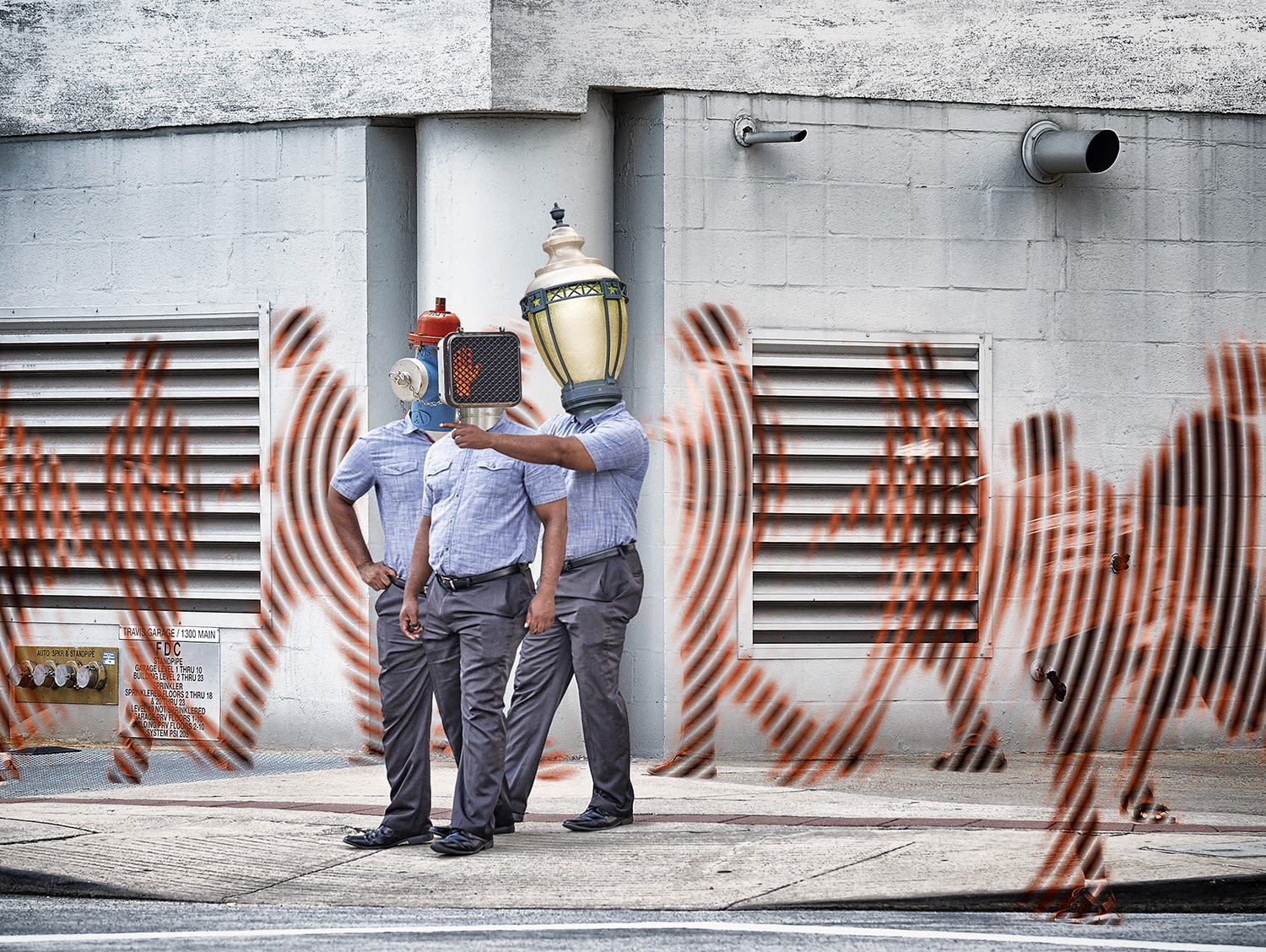
Holmes returns to fading the figures in “Impending Exposure”, but gives them a movement like distortion reminiscent of André Kertész’s “Distortions” work. (9) In this image, Holmes chooses to leave out an instructive street sign. His messaging is primarily the visual of actual figures of people in motion, although there is one inanimate object added to a person walking and talking on a cell phone.
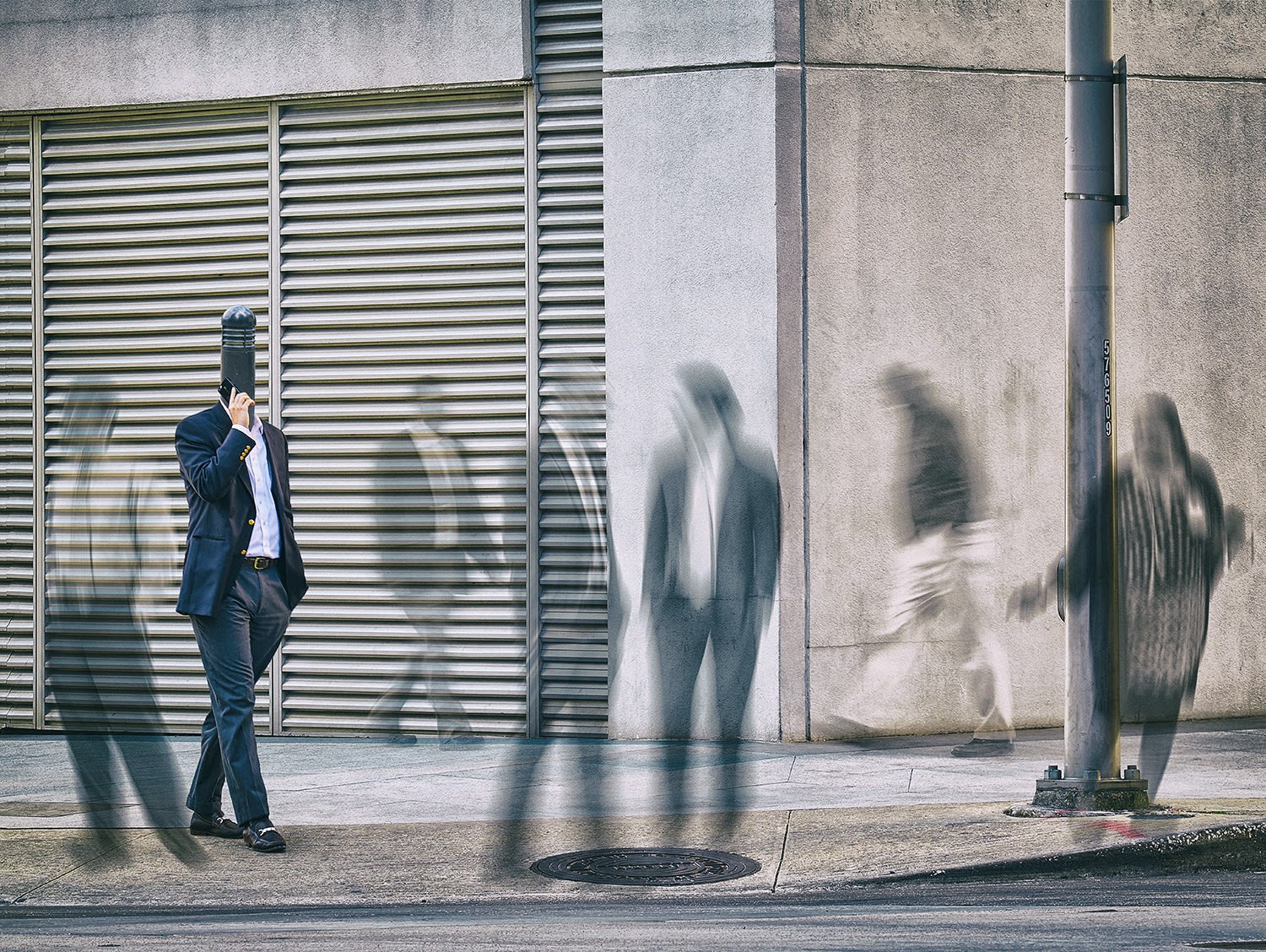
A similar effort is made in “Untitled #12”. However, he reverts to showing all the images except one, as silhouettes of the actual people. Literally, shadows of themselves. It makes us feel the indifference of others in the city as we walk along very crowded streets, yet feel very much alone. And, while the background remains neutral, the one “person” in color in the image carries a traffic control box, or sign, as a lunch pail or briefcase. One can read many things into the image, but it seems the artist has not lifted the burden of the message of “control” and instruction that society puts on us to manage our movement as part payment for the right to coexist with others in a city, on the streets in this urban environment.

The next image image of this body of work, “M.A.”, is an image that takes us full circle back to photography’s origins. The work is only a single person, in motion , against a selected background. Holmes asks individuals he knows to dress in cloths of a certain color. He looks for a particular location with color characteristics that complement the dress of the individual in motion, not unlike a black background for the stroboscopic work of Edgerton or Abbott. The artist seems solely focused back on an artistic visual image, using the camera as a tool used in a traditional manner, again, without any unusual manipulation of the image; a straight forward attempt, even more straight forward than the very first image, “Don’t Walk”. Holmes went back to the very beginning, and in effect, took a step back from that. The image is still very effective, and more purely photographic than the others.
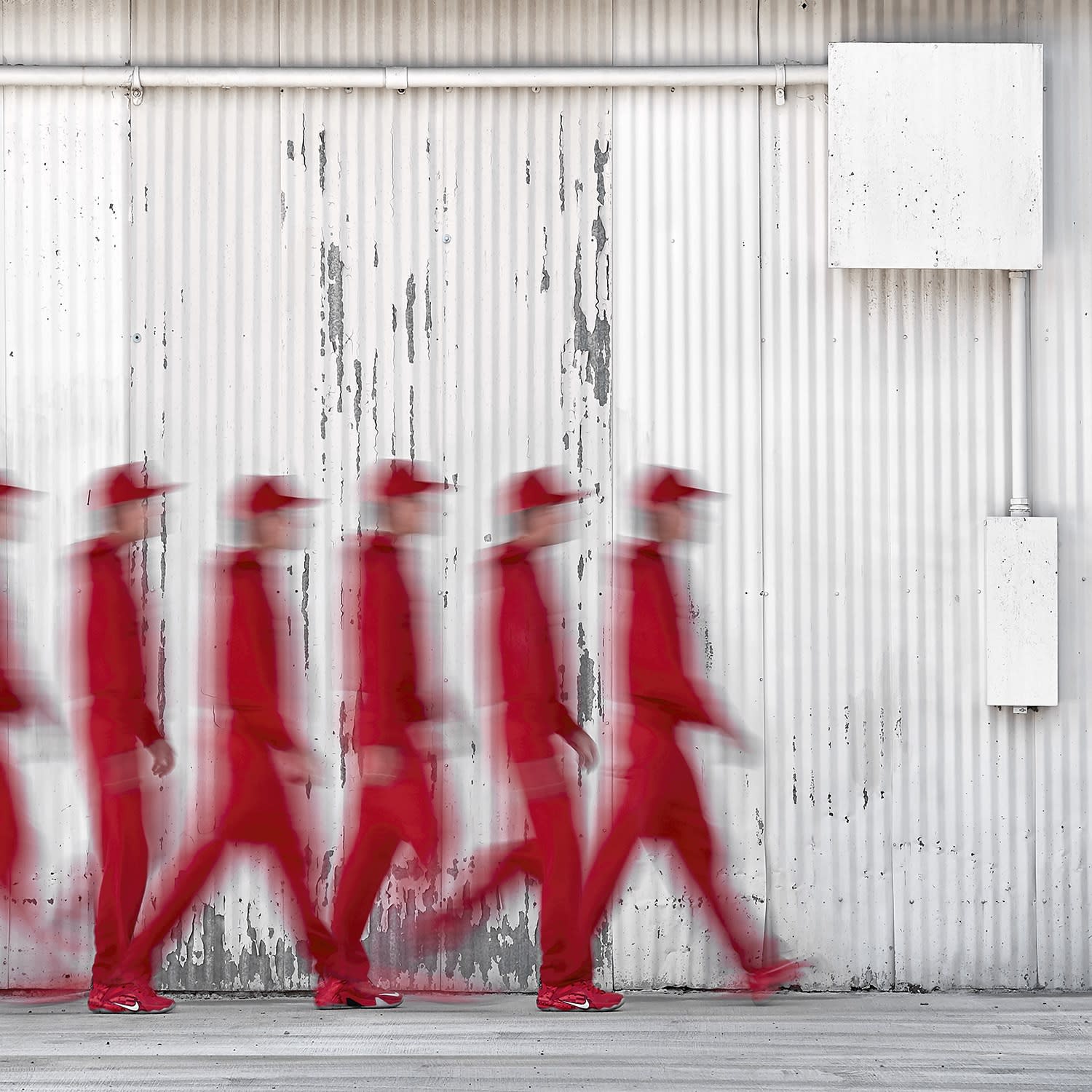
The final image we discuss in this series, “N.S.”, is a nude, making a statement not only about our actions, but society’s imposed norms on how we dress; what is appropriate to wear, or not, when and where.This image is a most basic statement about our movement through society, space and time. This image harkens back to the images by Muybridge where the human figures in motion were all done sans clothing. Unlike Muybridge, the image is not to study motion, but to create artistic expression. The image, while an isolated figure against a neutral background, as with other of his images, is at a very busy intersection, a five lane street in the middle of the day with a constant flow of traffic. The artist has brought us back to their discomfort with the hustle, bustle, isolation and loneliness felt while in the middle of large groups of people. Like the prior “M.A.” image, this is again a return to a basic image, not fabricated or artificial. Its an image that challenges us and makes a firm commentary on what we take for granted when we rise in the morning, bathe and put our clothes on before we venture out in the street.
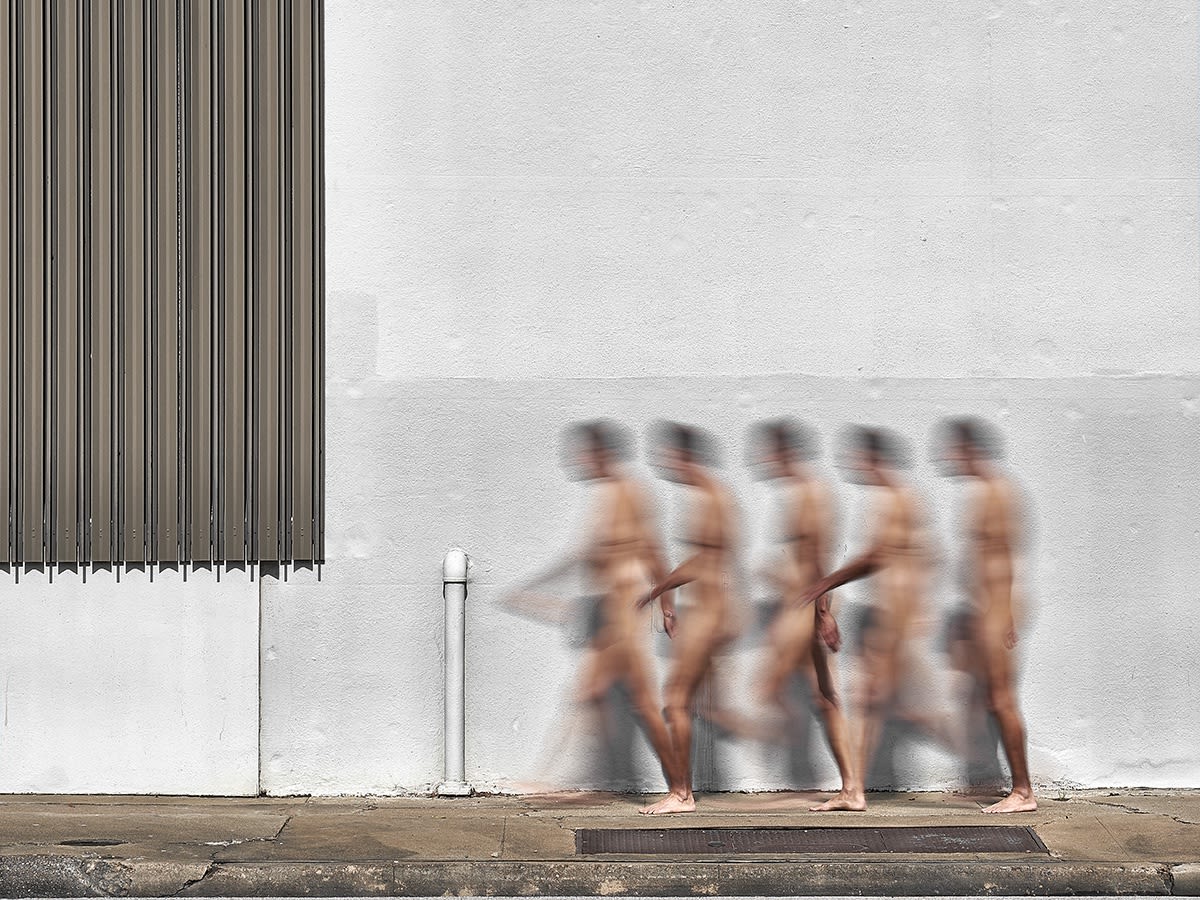 Image by Martin Holmes, “N.S.”, 2017˙©
Image by Martin Holmes, “N.S.”, 2017˙©
Martin Holmes’ series “Time Slip” series of “Street Portraits” and “Throwing Bones” are special. We can see photography used to create art by someone who is not trying to produce a classic “photograph”, yet ends up with something thoughtful and special. He is a conceptual artist with each photograph a completed image; but, not a completed, defined process. His work is useful both for its visual expression, and as an example of a fearless determination to keep working a concept and an image until the artist abandons the effort, possibly to be revisited, or reaches a sense of accomplishment and even fulfillment. The series also reminds us that all topics, as much as we feel it may have been thought about, talked about, visualized and photographed; can always be thought about, talked about, visualized and photographed in a new and inventive way to give the viewer a new way of seeing and thinking.
Notes:
- Excerpted from Mary Street Alinder’s book’ “Group F.64: Edward Weston, Ansel Adams, Imogen Cunningham and the Community of Artists Who Revolutionized American Photography”, Bloomsbury Press, 2014.
- See Henri Cartier-Bresson’s 1932 iconic image “Derriere La Gare Saint-Lazare”.
- See examples of the work of Harold E. Edgerton at http://edgerton-digital-collections.org/galleries/iconic/page/2 and http://archive.artsmia.org/get-the-picture/print/abbott.shtml
- “The History of Photography: from 1839 to the present day”, Beaumont Newhall, THe Museum of Modern Art and The George Eastman House, New York, 1964
- Modified from the artist statement on the artist’s website written by this author. http://www.mholmesphoto.com/throwing-bones/
- Op cit. “A History of Photography”, pg. 221
- Op Cit., Mary Street Alinder’s book’ “Group F.64: Edward Weston, Ansel Adams, Imogen Cunningham and the Community of Artists Who Revolutionized American Photography”
- Webster’s New World Dictionary, 4th Edition, Wiley Publishing, 2004.
- See “Distortions” by André Kertész, Alfred A. Knopf publishers, New York, 1976.